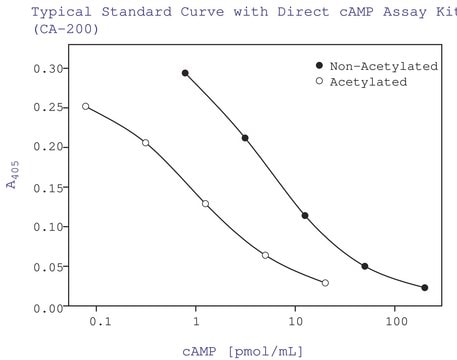CG200
cGMP Enzyme Immunoassay Kit, Direct
sufficient for 96 assays
About This Item
Produits recommandés
Utilisation
sufficient for 96 assays
Niveau de qualité
Technique(s)
ELISA: suitable
Conditions d'expédition
wet ice
Température de stockage
−20°C
Informations sur le gène
human ... PRKG1(5592) , PRKG2(5593)
Application
Composants de kit seuls
- 0.1 M Hydrochloride Acid 1 x 30
- Acetic Anhydride 1 x 1
- cGMP-Alkaline Phosphatase Conjugate 1 x 5
- cGMP EIA Antibody Rabbit Anti-cGMP 1 x 5
- Cyclic GMP Standard 1 x 0.5
- Goat Anti-Rabbit IgG Coated 96 Well Microtiter Plate 1 ea
- Neutralizing Reagent 1 x 6
- p-Nitrophenyl Phosphate Substrate Solution 1 x 20
- Plate Sealer 1 ea
- Stop Solution 1 x 5
- Triethylamine 1 x 2
- Wash Buffer Concentrate 1 x 30
Mention d'avertissement
Danger
Mentions de danger
Classification des risques
Acute Tox. 2 Inhalation - Acute Tox. 3 Dermal - Acute Tox. 4 Oral - Eye Dam. 1 - Flam. Liq. 3 - Met. Corr. 1 - Skin Corr. 1A - STOT SE 3
Organes cibles
Respiratory system
Risques supp
Code de la classe de stockage
3 - Flammable liquids
Point d'éclair (°F)
120.2 °F
Point d'éclair (°C)
49 °C
Certificats d'analyse (COA)
Recherchez un Certificats d'analyse (COA) en saisissant le numéro de lot du produit. Les numéros de lot figurent sur l'étiquette du produit après les mots "Lot" ou "Batch".
Déjà en possession de ce produit ?
Retrouvez la documentation relative aux produits que vous avez récemment achetés dans la Bibliothèque de documents.
Notre équipe de scientifiques dispose d'une expérience dans tous les secteurs de la recherche, notamment en sciences de la vie, science des matériaux, synthèse chimique, chromatographie, analyse et dans de nombreux autres domaines..
Contacter notre Service technique











